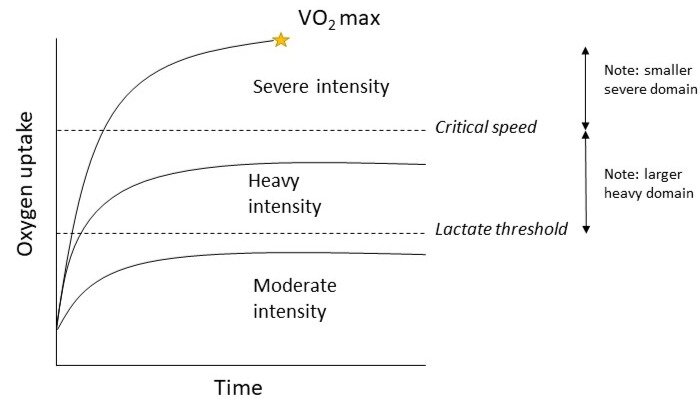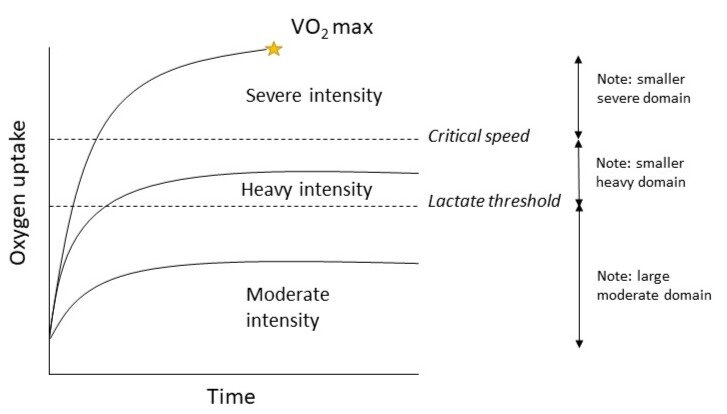Why VO2 max is a poor predictor of success in the mountains
By Scott K. Ferguson, Ph.D. | Co-Founder and Head Coach
Photo credit: Ben Matthews (@bentommat)
Maximal oxygen uptake (VO2 max) is known as one of the fundamental tenants of aerobic function and many athletes are excited to find their number to see how they compare to elite athletes. We also see loads of photos and videos showing chiseled athletes running or cycling while wearing masks connected to a machine, which let's face it, looks pretty cool, and probably sells loads of sports drinks. However, while VO2 max provides loads of information about how well the individual can take up and utilize oxygen, it may not be the best predictor of performance in the high country. In this post, we will discuss why it's important to measure other indicators of aerobic function and how relying only on the almighty VO2 max may mislead your appraisal of your physical abilities. If you haven't already checked out our three-part series on thresholds and the dichotomy of endurance training, you should defiantly give that a read first since we will revisit some of the terms discussed in those articles (they also have a few photos of a not-so-chiseled athlete running with one of those cool masks on too).
What is VO2 max?
As the name implies the VO2 max is the maximal amount of oxygen that the body can take up and consume and is determined by the coordinated effort of the pulmonary (lungs), cardiovascular, and muscular systems. For most animals, oxygen consumption occurs all the time and is determined by the metabolic rate (or need for oxygen). You can think of the metabolic rate as the gas requirement (or petrol for some of you) to keep your car running. Without enough gas to maintain an idle, your engine stops. The same is true for our bodies. At an idle, known as our resting metabolic rate, our body has a requirement for oxygen and this requirement changes rapidly when we go from rest to exercise. During maximal exercise, when we push our bodies to the limit, we reach the ceiling of our abilities to take up and utilize oxygen. Whether this limit comes from the lungs, cardiovascular, or muscular systems is determined by a host of factors that we can discuss in a future post, but what is key to remember for now is that the maximal oxygen uptake (VO2 max) occurs when oxygen delivery and utilization are at their max value possible for that individual. This max value can occur at any work rate and differs between individuals and even within individuals when measured before and after several weeks or months of exercise training. When you consider that training can raise VO2 max and that many elite endurance athletes have a high VO2 max, it's easy to assume that a high VO2 max must mean greater performance across the spectrum of aerobic activities, or that an unchanged VO2 max following weeks and months of training means that the training was ineffective. But that's not always the case, especially at high elevations where there is less oxygen per breath due to the lower barometric pressure.
As we outlined in our previous discussion on thresholds, when exercise is performed in the severe intensity domain, the athlete is on borrowed time since, among other things, their oxygen uptake will continue to creep upward until it ultimately reaches VO2 max and exhaustion occurs. Remember that critical speed is the important threshold that separates sustainable vs. unsustainable exercise (i.e., it separates the heavy and severe intensity domains). What is important to understand is that it is possible to have a high VO2 max and a relatively lower critical speed, such that the severe intensity domain is large. It's also possible to improve your highest sustainable speed without changing VO2 max. Let's dig into this a bit deeper with some illustrations.
The healthy but untrained individual
Theoretical pulmonary VO2 responses to constant work-rate exercise in a healthy but untrained (soon to be) athlete.
The illustration to the right shows a theoretical VO2 response to three different constant work rate exercise bouts (constant meaning the work rate doesn't change from start to finish). An exercise bout in the moderate domain would be considered easy by the athlete. This is an intensity they could maintain for many hours and could easily carry on a conversation while performing the activity. For a healthy individual, this would be like walking across campus or to your car across a large parking lot while maintaining a comfortable pace. For the well-trained athlete, this could be an easy run depending on their fitness level. A key feature to note is that oxygen uptake is able to stabilize in the moderate domain.
If we increase the workload for the next bout, we would see the VO2 profile settle into a steady-state between the lactate or gas exchange threshold and the critical speed. While we are able to reach that steady-state of oxygen uptake, this intensity will feel noticeably more difficult for the athlete. Most individuals might consider this the fun-zone since training around this intensity feels good and actually makes you work. Spending the majority of your training time in the heavy domain would be considered following the "threshold training model", which we discussed in this article. For this theoretical subject, notice how small the heavy domain is when compared to the moderate and severe domains. Did you remember that any intensity above critical speed is unsustainable and will ultimately result in exhaustion? Keeping this in mind, it's clear that there's not a lot of room to play in the fun-zone since the athlete quickly goes from easy to unsustainable exercise intensities with very slight shifts in workload. While performing a graded exercise test to measure VO2 max may also allow you to determine your moderate, heavy, and severe intensity domains, it should begin to be clear that the VO2 max number itself doesn't provide the full picture of fitness.
Theoretical pulmonary VO2 responses to constant work-rate exercise in a moderately-trained athlete.
The pretty fit individual
If we repeat the series of exercise bouts while measuring VO2 after the same athlete has undergone several months of exercise training, the size of the domains will have likely shifted, even if VO2 max remains unchanged. In figure 2 (to the right) we can notice that while VO2 max has not changed following training, we have raised the athlete's critical speed. Thus, this athlete has more play in the heavy intensity domain and a higher sustainable work rate than before they started training. This means that this athlete is now able to sustain exercise at a higher workload before they pass into the severe intensity domain. Since the critical speed is closer to the individual's VO2 max, they are able to operate at much closer to their maximal work rate without exhaustion rapidly occurring. Notice, however, that while we have increased the athlete's sustainable work rate, we have only done so by raising the critical speed to a speed closer to the individual's VO2 max, we have not necessarily altered VO2 max (although it is likely that both VO2 max and critical speed would increase with training).
The well-trained athlete
Theoretical pulmonary VO2 responses to constant work-rate exercise in a well-trained endurance athlete.
Following months and even years of training using a polarized training method, we might see something as we see in our final figure. In this case, the athlete has spent the majority of their training time well below the lactate threshold, and in doing so, has increased the size of their moderate-intensity domain. This is fantastic news since the moderate domain (also called the easy domain) represents exercise that our athlete can maintain for a long period of time. For the mountain athlete, this is likely where you will be spending the majority of your time during your event. Take for example an ultra-marathon runner, who will spend the majority of a 100-mile race well below their critical speed. For this athlete, the larger moderate domain means that they can operate closer to those higher thresholds without incurring the physiological penalties that arise for someone less trained. Raising both the critical speed and the lactate and gas exchange thresholds should be some of the primary goals for a mountain athlete. In doing so, we raise the athlete's highest sustainable work rate while also improving their metabolic control when exercising at these intensities.
When I assess an athlete, either when we first start working together or to measure the progress of their training, I'm much more interested in determining their critical speed and lactate thresholds than I am about knowing their VO2 max. This is because we can have profound changes in performance, without necessarily changing VO2 max by improving how their body responds to a variety of physical work intensities. So how can you measure these thresholds, or what if you've had your VO2 max measured at a lab only to be left wondering how to use your data? These are both topics I plan to discuss in future posts so that you have a better idea of how we utilize metabolic data for our athletes and so that we can discuss how you can use these numbers to inform your training.
So what did we learn today?
While VO2 max is an important value, it doesn't necessarily determine the performance capabilities of the athlete.
Understanding where your critical speed and lactate/gas exchange thresholds lie can provide considerably more insight into your progress as an athlete and the effectiveness of your training when compared to VO2 max alone.
Raising both critical speed and the lactate/gas exchange thresholds means a higher sustainable workload for the athlete, and should be the goal of a well-constructed training program.
The polarized endurance training model is heavily relied upon by endurance athletes to instill the beneficial structural and functional changes required to raise the critical speed and lactate/gas exchange thresholds.
While these are my viewpoints on these topics, I want to know what you think about VO2 max and the domains of exercise intensity! Please leave your comments or questions below or feel free to reach out to us via our contact page.




